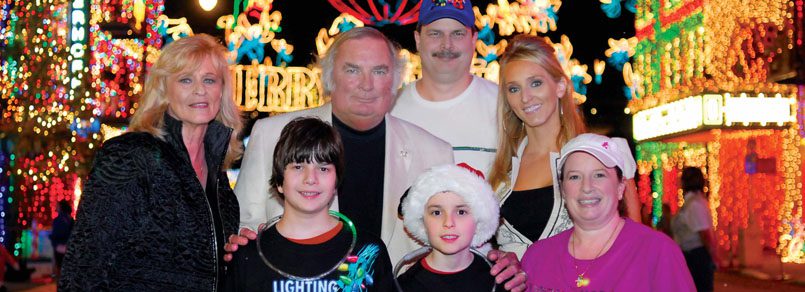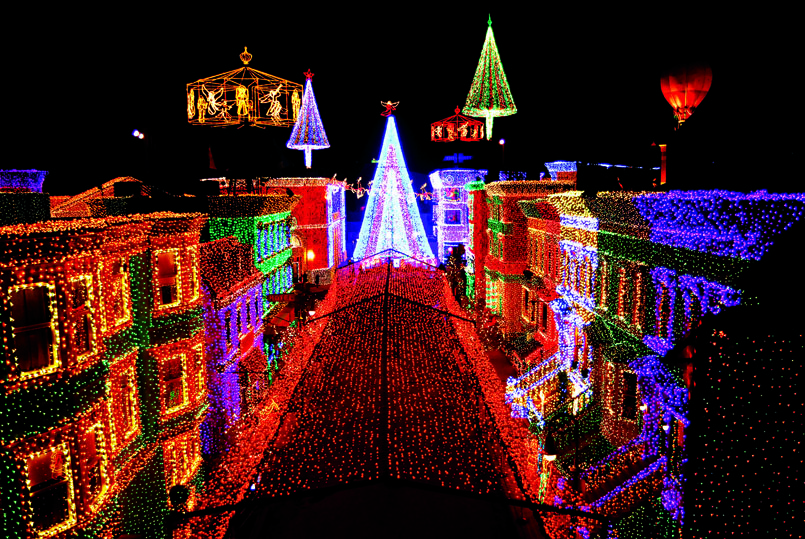30 Nov 2021 The light fantastic
By Dwain Hebda
In the Christmas movie “National Lampoon’s Christmas Vacation,” Clark W. Griswold wants to create the granddaddy of all Christmas displays. He installs and throws the switch on 100,000 exterior lights, causing the city to dim and the utility company to change to auxiliary nuclear power.
As they say, truth is much stranger than fiction and compared to what annually sprang up on Little Rock’s Cantrell Road in December between 1986 and 1995, Griswold’s display was amateur at best. For it was there that the mother of all residential Christmas lights displays could be found, at the home of businessman and philanthropist Jennings Osborne.

“My father was very passionate, he was an envelope-pusher, he did not do anything in moderation,” said Breezy Osborne-Wingfield, Jennings’ daughter. “He definitely wanted to do things out of the norm, out of the box, but he wanted everyone to be able to experience it. He did enjoy that awe factor.”
Born of meager means, Jennings made his fortune through his company, Arkansas Research Medical Testing Center, and in 1976, purchased a sprawling home along Cantrell Road. Ten years later, the story goes, 6-year-old Breezy uttered the words that launched a million lights.
“We’d go get some apple cider and drive around town and look at Christmas lights,” she said. “And I said, ‘Can we have some on our house?’”
The first year was pretty pedestrian, especially by Jennings’ usual standards. Workmen remember hanging lights on the wall surrounding the property and on the side of the house, all red. The next year, Jennings’ vision had changed.
“There was a house right down on Cantrell just past us a ways on the opposite side of the road and he’s like, ‘Hey, you know that house down there?’ I said, ‘Yeah.’ He said, ‘I’d like to beat it,’” said Richard McCormac, longtime jack-of-all-trades handyman who started working for Osborne in college. “I said, ‘Man, you can do anything with this house of yours. It’s big enough.’ So, he’s like, ‘I’d like to have something on the wall, like maybe a reindeer and sleigh.’ OK, so we did that. Made it out of plywood and outlined it. Then a nativity scene.”
Each year was a catalyst for the next. Breezy remembers her father obsessing over how to push the Christmas display over the top, then finding another top just to push it over that.
“Dad would wake up in the middle of the night and literally write down what he dreamed because he had an idea on what to do with the Christmas lights,” she said. “It was truly dreamed of.”
Jennings’ limitless imagination — combined with adequate resources — meant nothing was too big, too bright or too much. Bret Franks, a college buddy of McCormac’s, was recruited to help with the display.

“My main job was to cover the roof and then do whatever else,” Franks said. “I remember one year, we put 2,000 lights on a picnic table. I’m not kidding. I put 20 strands on a picnic table. I mean, it was like get as many lights on these things as you could get on there.
“Going back to the first couple of years, we would go around to the stores and just buy every red light we could buy. We would go to Benton and Hot Springs and Conway and wherever and we would buy the store out. And it got to where there were no more lights around here, so he started shipping them in from China. Jennings didn’t give a rip. Whatever he wanted to do, he did it.”
McCormac, now mayor of Clinton, would come to spend six months bringing Jennings’ vision to life. Memorable projects were a 70-foot welded Christmas tree perched on the roof; twin carousels, each 30 feet in diameter; and a 30-foot decorated steel globe suspended from a crane. McCormac remembers enlisting a small army of fabricators, welders, electricians and up to 50 installers to bring everything to life.
“It got a little more complicated as time went on,” he said in a massive understatement. “But you never say no to the King, man. Right? No, we never did say no.”
In fact, there were people who would say no, starting with six neighbors who filed a lawsuit in 1993 saying the solid logjam of cars stopped in the street to look at the display was creating safety issues. Jennings, who by that time had taken to circulating throughout the throng handing out massive candy canes, was unrepentant to say the least, adding 3 million lights to the menagerie in response to the motion.
A county court didn’t shut it down, but limited it to 15 days (it had run for as long as 35) and only during certain hours. Jennings appealed to the Arkansas Supreme Court and then the U.S. Supreme Court, all to no avail. In 1995, the state Supreme Court pulled the plug.
Some of the display went to Arkansas communities to decorate Main Street, but most of it, in an epilogue that could only happen in Jennings’ reality, was acquired by Walt Disney World, which over time augmented the display to over 5 million lights. “The Osborne Family Spectacle of Lights” delighted park goers for a decade before going dark for good.
Today, 10 years after her father’s passing, Breezy thinks back on the display as a precious gift, albeit one meant to be shared with the entire city.
“Dad used to joke with me and say, ‘Buddy, you don’t know what it’s like to be normal, do you?’ I was like, ‘No.’ And I mean, I’m fine with it. That is the way that he lived his life and it’s just the way that we were raised,” she said.
“I have a really good, solid memory of when the house was all red, before different colors were introduced. That gave it this nostalgic, down-home feeling. I still have red Christmas lights I use to decorate our tree at home or put on our back porch. I have some red Christmas lights that I keep in the house all year long. That sticks out in my memory, for sure.”
- The pinnacle of success - June 1, 2025
- Five-Oh-Ones to Watch 2025: Aaron Farris - December 31, 2024
- Julia Gaffney brings medals and mettle home to Mayflower - October 30, 2024








